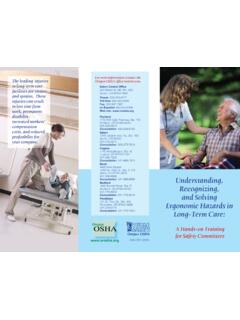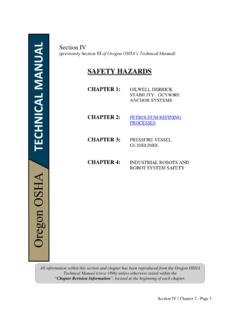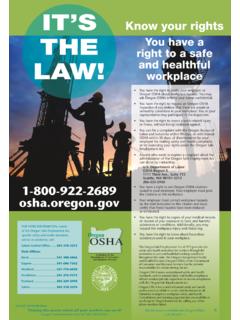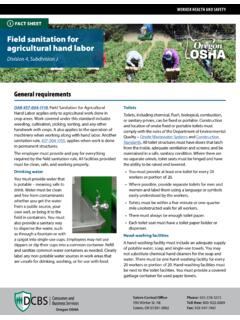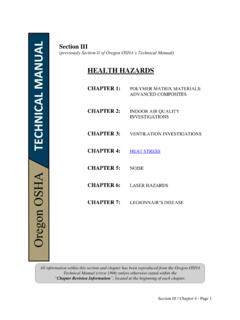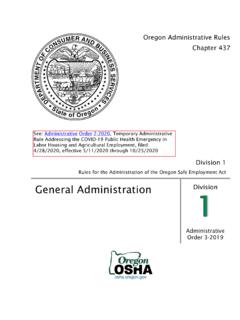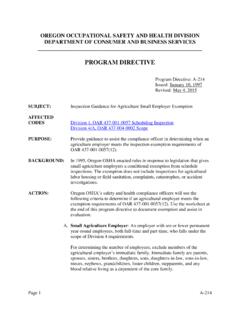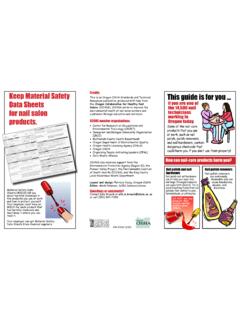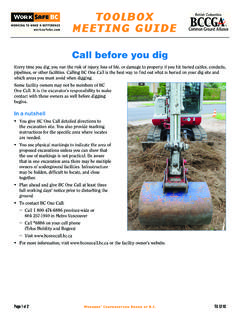Transcription of Call before you dig - osha.oregon.gov
1 Volume 55 onlineHealth and SafetyOregon OSHA October- November 2017 call before you dig: Addressing the hazards of underground utilities p. 6 New walking-working surface rules:Effective Nov. 1 p. 9 Going the DistanceMeet Kaci Buhl, coordinator of the Statewide Pesticide Safety Education Program p. 24 RESOURCEO regon Health and Safety Resource is published every other month by the Oregon Occupational Safety and Health Division of the Department of Consumer and Business of Consumer and Business Services Pat Allen, DirectorOregon OSHA Michael Wood, AdministratorResource editor Aaron CorvinDesign and illustration Patricia YoungDCBS editor Mark PetersonReprinting, excerpting, or plagiarizing any part of this publication is fine with us. Please send us a copy of your publication or inform the Resource editor as a you have questions about the information in Resource, please call general information, technical answers, or information about Oregon OSHA services, please call 503-378-3272 or toll-free within Oregon, s Message 3 Oregon s comprehensive approach to worker safety continues to pay offDon t miss out 4 Upcoming eventsDid you know?
2 5 Potential hazards of underground utilitiesFeatures 6 call before you dig 8 Digging best practices 9 New walking- working surfaces rules14 Surfaces rules with delayed effective datesShort takes 15 New Oregon OSHA statewide safety enforcement manager16 Scholarship awards17 Workers comp costs to drop18 AGC PRIDE award winner19 Compressed air for cleaning20 COSHA Juniper award winnerSafety notes21 Finger amputationAsk Technical23 Fire extinguishers on forklifts? Dress code for electricians? Going the Distance24 Meet Kaci Buhl of the Statewide Pesticide Safety Education ProgramOregon OSHA Administrator The least expensive claim is the one that is never filed because the injury or illness never occurs. Workers compensation premiums show one measure of Oregon s successBy Michael Wood Last month, the Department of Consumer and Business Services, of which Oregon OSHA is a part, announced that the average pure premium rate for Oregon workers compensation would see yet another meaningful reduction in January 2018.
3 The 14 percent decrease in the average rate represents the fifth consecutive drop and a total 33 percent decrease since 2013. Oregon will see its average rates drop to the seventh lowest in the country, in spite of having better than average those numbers, as encouraging as they are, do not tell the complete story. Since the workers compensation reforms of the late 1980s reforms that also focused on injury prevention and that included the creation of Oregon OSHA in its current form the average premiums have dropped year after year. For two decades, Oregon s rates decreased steadily with only four years in which they saw no change. Finally, in 2012 and 2013, the average pure premium rate rose slightly (by percent and percent). But even those modest increases were almost immediately overcome with a percent decline in who keep an eye on national trends know that Oregon has for years been bucking those trends when it comes to workers compensation costs.
4 Part of that success is the result of effective return-to-work efforts, as well as success in keeping medical costs under control. But a continuing part of Oregon s success is the result of our early recognition of a simple principle: The least expensive claim is the one that is never filed because the injury or illness never occurs. Primary prevention works. And that s the goal that workplace health and safety professionals, workers, and employers throughout Oregon have pursued. Oregon has taken a comprehensive approach to workplace health and safety for years. And we have relied upon effective partnerships between employers, their workers, the insurance carriers, and government to make safer workplaces a reality. That comprehensive approach has paid off. It continues to pay dividends in decreasing the cost of doing business in the state.
5 And it pays even more important dividends every time an Oregon worker finishes the day or completes a working career whole and healthy and able to enjoy all that life has to s a job well done. And it s a job worth celebrating!ADMINSTRATOR S MESSAGE3 DON T MISS OUTDon t miss outEducation: October-December workshopsPUBLIC EDUCATIONFor more information: the most recent public education schedule updates: 17-19, 2017 Ashland Hills Hotel & SuitesExhibits Awards WorkshopsQuestions? or to receive registration materials, contact the Conference Section, 503-947-7411 or toll-free in Oregon at 888-292-5247, option 1 now! 27th AnnualSouthern Oregon Occupational Safety & Health Conference10/18/2017 ..8 ..Eugene ..Hazard Identification and Control10/18/2017 ..1 ..Eugene ..Job Hazard Analysis10/31/2017 ..8 ..Salem ..Worker Protection Standard10/31/2017.
6 1 ..Salem ..Hazard Communication - Aligned with GHS11/21/2017 ..8 ..Roseburg ..Safety and the Supervisor11/21/2017 ..1 ..Roseburg ..Safety Meetings and Committees12/6/2017 ..8 ..Bend ..Worker Protection Standard12/6/2017 ..1 ..Bend ..Hazard Communication - Aligned with GHS12/13/2017 ..8 ..Milwaukie ..Safety Meetings and Committees12/13/2017 ..1 ..Milwaukie ..Job Hazard AnalysisNovember 28-December 1, 2017 Red Lion Hotel on the River Jantzen Beach Portland, OregonThe 27th annual safety and health conference is specially designed for the pulp, paper, and forest products industry. An excellent workplace safety and health training resource! Exhibits Awards Industry networkingPartners in Safety Steering Toward the FutureFor more information go to: Pulp, Paper, & Forest Products Safety & Health Conference27th Annual4 Quotable:Did you know?
7 Error is pervasive. The unexpected is pervasive .. What is not pervasive are well-developed skills to detect and contain these errors at their early stages. Karl E. Weick, co-author of Managing the Unexpected: Sustained Performance in a Complex World. When it comes to excavations and the potential hazards of underground utilities, Oregon OSHA s specific requirements are: The location of utilities must be determined before opening an excavation The exact location of the installations must be determined by safe and acceptable means While excavations are open, underground installations must be protected, supported, or removed as necessary to safeguard employees Of course, there are other excavation rules that go beyond underground utilities. They include specific excavation requirements and requirements for protective systems. It s all spelled out in Oregon OSHA s Division 3/Subdivision before you dig reduces the chance that something will go wrong when you start a job.
8 Consider the following before you start excavating: Debris near the excavation site that could create a hazard How employees will get in and out of the excavation How to protect people from falling into the excavation How to respond to emergencies Location of overhead power lines and underground utility lines ( call 811 from anywhere in Oregon for help in locating underground utility lines) Possibility of atmospheric hazards in the excavation Possibility of water in the excavation Stability of soil at the excavation site Stability of structures adjacent to the excavation site Vehicles and other mobile equipment that will operate near the excavation Weather conditions Dig a hole in the ground and you ve made an excavation. Excavations can be any size: wide, narrow, deep, or shallow. A trench is a narrow excavation, not more than 15 feet wide at the bottom.
9 If you install forms or other structures in an excavation that reduce its width to less than 15 feet, measured at the bottom, the excavation is also considered a trench. If you work in an excavation that s five feet deep (or deeper), you must be protected from a cave-in. If a competent person determines that there s a potential for an excavation to cave in, you must be protected, regardless of its depth. A cave-in can trap you within seconds and kill you within minutes. Two cubic yards of soil weigh about 6,000 pounds. If you re buried, you ll suffocate in less than three minutes. Even if you survive, the weight of the soil is likely to cause serious internal injuries. 5 DID YOU KNOW?datapoints:By Aaron Corvin and Kandi YoungFor the construction and utility industries, using the Oregon Utility Notification Center s 811 service perhaps better known for its tagline call before you dig is critical.
10 After all, the potential ripple effects of failing to take that crucial step before breaking ground in an area that may contain buried water, electricity, or natural gas lines include lives injured or lost, buildings damaged or destroyed, and financial costs that only pile far this year, Oregon OSHA, whose jurisdiction is worker safety, has issued seven citations to companies for failing to secure locations of underground lines before opening excavations. Those citations have totaled more than $13,000 in initial penalties. Four other investigations of such incidents remain , Oregon experienced more than 2,000 line strikes in 2016 alone, according to the Oregon Public Utility Commission, whose program includes enforcement of utility safety standards. Nationwide, a line strike occurs every six of which is to say that, while using the 811 service is common practice for certain industries, its importance is sometimes lost in the rush to move dirt.
